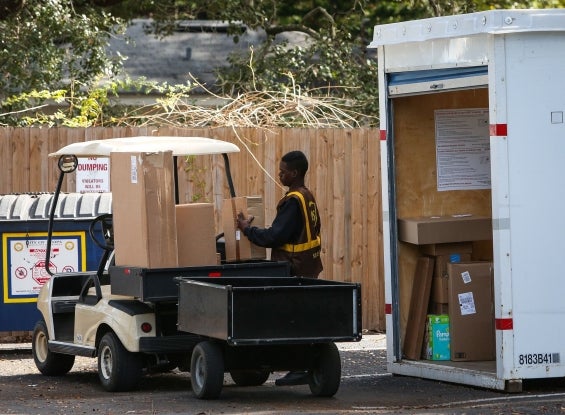Headline News
WSJ: Teamsters Push Back on UPS Golf Cart Delivery Vehicles

Wall Street Journal, June 29, 2017
United Parcel Service Inc. uses jumbo jets, hybrid electric vans and, sometimes, drones to deliver nearly 5 billion packages each year. But a push into a less glamorous transportation method—golf carts—has touched a nerve with drivers in one of its home bases.
Starting Thursday, UPS can use golf carts to deliver packages in Kentucky thanks to a new state law allowing delivery drivers to use the vehicles on public roads. The company plans to use retrofitted golf carts to complement its fleet of brown delivery trucks primarily during the winter holidays, when daily volumes can rise two-thirds from normal levels.
But union leaders, who had opposed the legislation, argue that having the vehicles share the road with cars and trucks puts workers at risk. They also object because at UPS golf cart drivers earn less than traditional truck drivers.
“They’re just looking to pay the drivers less at the expense of the safety,” said James DeWeese, a member of Teamsters Local 89, which represents UPS drivers in Kentucky.
UPS spokesman Glenn Zaccara said the carts undergo a major face-lift from the ones spotted on fairways. The vehicles will have turn signals, seat belts and a emblem designating it a slow-moving vehicle.
“The safety of our [workers] always comes first and we will not operate in conditions that are determined to be unsafe,” Mr. Zaccara said.
UPS, which has its main WorldPort package sorting hub in Louisville and is the state’s second-largest employer behind Wal-Mart Stores Inc., lobbied for the law, which passed the Republican-controlled House and Senate by roughly two-to-one margins.
The golf carts, which are modified with a flatbed or pull a trailer containing the packages, will be driven by part-time workers. The carts generally don’t go faster than 15 miles per hour and will only be allowed to be operate in residential areas and on public roadways with a posted speed limit of 35 miles per hour or less.
Mr. Zaccara said using golf carts will give UPS more flexibility during the holidays than having to buy new delivery trucks or vans. The electric golf carts can travel between 25 and 40 miles on a single charge, UPS said.
Controlling costs is a major issue at both UPS and FedEx Corp. , which have taken steps to optimize driver routes through routing systems, automate more sorting facilities and deliver more packages to drop-off points like stores.
Mr. DeWeese said part-time workers driving golf carts made about $15 an hour, versus a starting rate of $18.75 an hour for Kentucky drivers behind the wheel of a truck or van. Most drivers in Kentucky make the maximum hourly rate of a little more than $35 after four years.
“It’s just an eroding of full time employment for people that need it,” Democratic State Rep. Rick Nelson said.
Mr. Zaccara said UPS’s goal was to find the most efficient way to “process the near double average daily package volume we experience during our peak season” in November and December.
UPS has a number of unique delivery methods to accommodate local quirks, including horse-drawn carriages on Michigan’s Mackinac Island and gondolas in Venice, Italy.
In the U.S., the delivery company’s national labor contract does allow for golf-cart deliveries. One sentence in the 184-page document states: “Golf cart usage will comply with applicable federal, state and local regulations.”
That provision was largely unobjectionable when the contract was ratified in 2013, said Mr. DeWeese, as it was inserted to accommodate deliveries in communities in places like Florida where golf carts are the primary mode of transportation.
The issue comes several months ahead of when the national Teamsters union is expected to begin negotiations with UPS over its next contract. The current version expires July 31, 2018.
Corrections & Amplifications
UPS’s golf carts will have turn signals, seat belts and a emblem designating them as slow-moving vehicles. An earlier version of this article incorrectly said they would also be enclosed and heated.